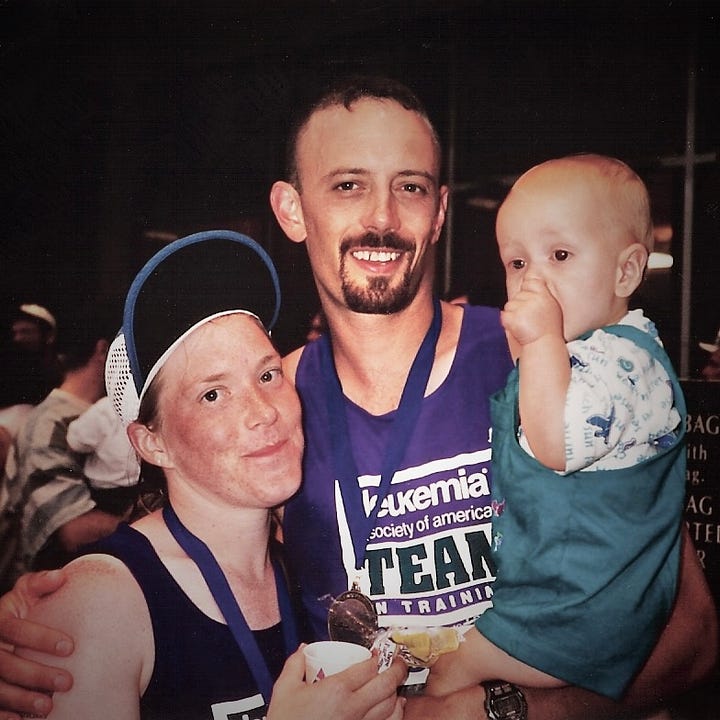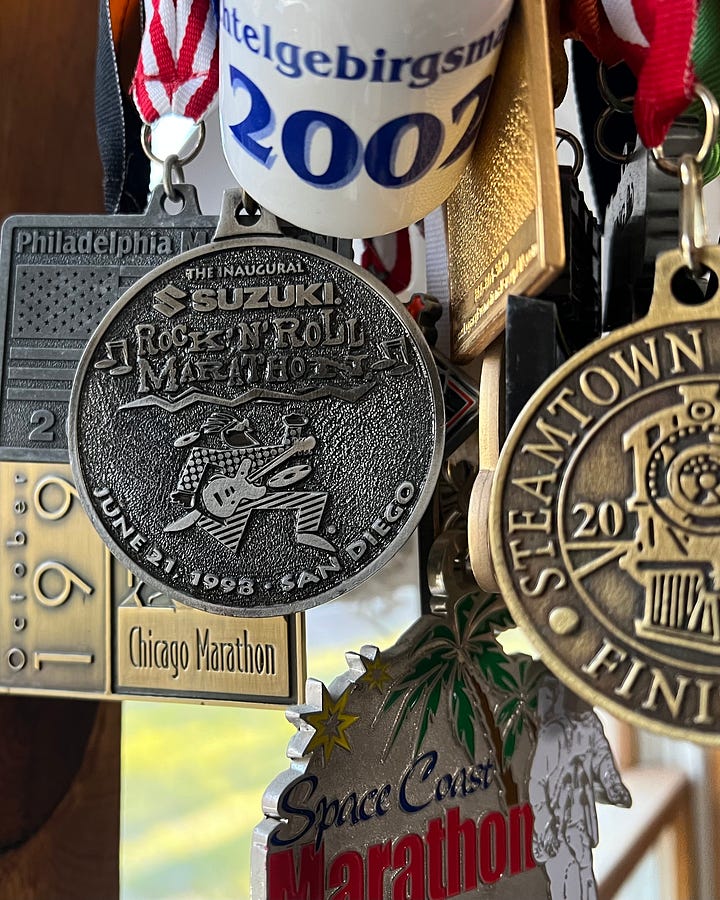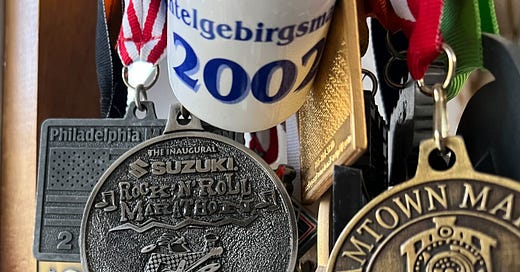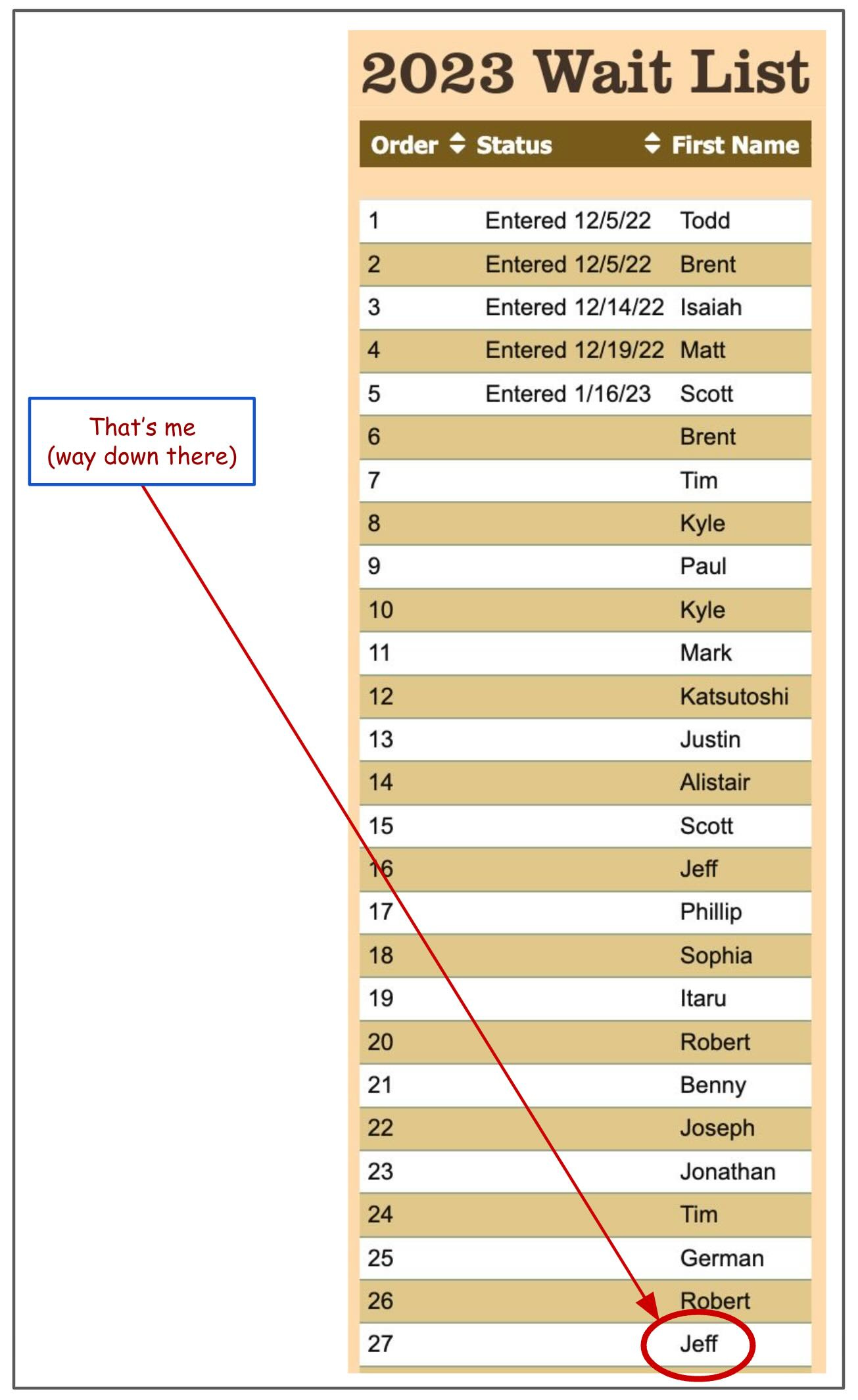Twenty-five years ago today, Renee and I made a pivotal life decision. On that day, January 18th, 1998, we decided that we were (or would become) long-distance runners1.
My only record of it is this little note in my datebook from that year:
Berlin: visited w/ Larry, Sandy, Mom, Dad, Bryan, Brad, Angie & kids, Grandma Shober, Bertha, Susan, Stacey — at Shober’s
Talked to Susan and Stacey about San Diego Marathon and Leukemia Team in Training
I don’t remember why we had a mid-January family gathering, and I don’t know why Susan and Stacey were looking at races. But I do know that for some reason we were receptive, and 2 weeks later we signed up for our first marathon.
We trained, we did our fundraising, and on June 21st, on our first-ever trip to California, we ran our first marathon (all four of us finished, with Lucas and our parents cheering from the sidelines).


(And here’s a side note, another bit of poetic and serendipitous synchrony to go with the developing theme of this post… my datebook had a third bullet for that same day: “Lucas walked”. So today is also the 25th anniversary of those auspicious first steps.)
So, this is all interesting, but it’s only nostalgia, right?
But what if it there’s more to it than that? What if I’ve managed to stumble my way from that long ago event into something with near-term, hands-on relevance, something that hints at a cosmic alignment of fairly epic proportions?
Well…
After 8 years, my name was finally drawn in the lottery for this year’s Western States Endurance Run2. So on June 24th, on the 25th anniversary of that first marathon (plus 3 days), I’ll be running for a second time in California, this time in the oldest and most celebrated of our modern hundred-mile races.
I couldn’t have planned it this way. Of the hundreds of 100-milers we have to choose from now, this one is the mandatory touchstone, the symbolic “pilgrimage to the source”, and I’ve been trying to get in since 2015. Of over 7,000 runners who entered this year, only 5% of us were selected.
I’m not superstitious. These patterns are coincidence, they have no power of their own. But I still watch for them, seek them out, because I know that I can give them symbolic power. And when it comes to motivation, power is power, and a symbol-seeker like me can hang a lot on a 25th anniversary like this one.
My Framework
So, how do I get from here to there?
I’ll start by setting the objective, then I’ll add some structure to the time (I see this as a 5-phase operation).
In the coming weeks, I’ll be taking a closer look at each of these phases, examining and refining my ideas about them, adjusting the details of my plan (and maybe expanding on them here). But here’s what I have so far.
The Objective
Here’s my standard hierarchy of goals for races:
“Yes” as the answer to this question: Did I do the best I could with this mind and body, on this course, under these conditions, on this day? (If that’s not my baseline, why am I even here?)
A finish. (In any long and difficult ultra, “a finish is a win”.)
A 100-mile PR. (For that, I must finish in under 24 hours and 27 minutes.)
A “reach-goal” — the goal at the outer edge of possibility, the one that inspires the hard training, the one I’ll go to sleep with every night for the next 5 months. Choose wisely. But also, remember the power of symbols… they give a silver buckle for running this 100 miles in a single 24-hour day.
Perfect. An objective worthy of a silver jubilee: I’m running Western States for a silver buckle, on the silver anniversary of my first marathon.
Phase I: Fallowing
(T-25 to T-19: 7 weeks of restful regeneration to set the stage for hard training)
It’s currently week T-23 (as in “target minus 23 weeks”), and I’m 2 weeks into this fallowing period.
I still run every day, and I’ve set a base-line standard of 50 miles and 5,000 feet of climbing per week. But my runs are easy — no pressure, no pushing. The important work in this phase is happening underground: my body is healing and regenerating (and learning to accept “50 & 5,000” as the new normal).
If I do this well, if I can contain my enthusiasm and let the fallowing do its work, I’ll arrive at the start of the next phase feeling fresh and strong and eager to get to work.
Phase II: Train-up
(T-18 to T-5: 14 weeks of serious training, peaking in T-5)
For that first marathon, I learned a standard 18-week training format: a steady week-to-week increase in mileage and difficulty that builds to a peak 4 or 5 weeks out from the race, then a 3 or 4 week taper to race day.
I’ve become much less formal about the content of my train-ups through the years, but I still follow that basic format. It makes sense to me both physically and psychologically, and it gives me an objective way of comparing my efforts from race to race and year to year.
For this race, I want to tighten things up a bit, be less ad hoc with my runs. It won’t be a strict daily schedule (I’ve learned the importance of flexibility), but it will at least take me in that direction. I’m still working on the details, but it will incorporate everything I’ve learned through the years about myself and my response to training.
Phase III: Taper
(T-4 to T-2: a 3-week taper that ends with our trip to California)
Tapering is an act of faith, and this is a time when wisdom must overcome ambition. There will be a strong urge to get in just one more big week, just one more big climbing day, but at this point, the potential benefits of more hard training are tiny, and the potential for harm is high. A good phase-III mantra? “Don’t do anything dumb”.
Phase IV: Race Week
(T-1: get there with all my stuff, and regroup for the final push)
Race Week is also Transcontinental Travel Week, with all the stress and joy that comes with that. Packing, airports and connecting flights, rentals and time zones. Also final gear configurations, and drop bag decisions, and fine-tuning the crew plan. And just enough running to keep a fine edge on my blade.
Phase V: Race Day
(24 hours of patient, focused intensity, as the culmination of 25 weeks of focused effort, after 25 years of sustained practice)
So, 25 weeks of training, and a lifetime of experience, all for this one day, when anything can happen… that’s quite a heavy load for a single day.
Except that sentence is wrong — it is not “all for this one day”. Yes, this day provides a point of focus, and in some ways the outcome of this race will be a measure of all that preceded it. But as anyone who has been doing this for a while knows, what it’s really “all for” is the journey itself. The journey is long, this day will be just a blip, and the journey will continue.
That said, I’m still going to do my very best to make it a beautiful silver blip…
Related
Yes, I’ve written about Western States before.
Here: Lottery Day
And here: Western and Eastern
Of course I ran before that, but only short distances, mainly to prepare for army PT tests. Before that date I have 100 recorded runs and a total of 270.6 miles — an average of 2.6 miles per run, and my longest-ever run to that point was 6 miles.
Well, sort of… I was actually drawn as the 27th person on the wait list. Historically, Number 27 has always gotten in, and I’m counting on that to happen again this year (the first five are already in — only 21 people ahead of me now!). Regardless, I’ll be there, in or still waiting for my spot. And one way or another I’ll do a jubilee run that day (but I really hope I can do it in the race).





Haha, I have been meaning to look up your rush of it all commentary and you made it easy to with the Strava link. So yes, I subscribed to Substack as well.
I am hoping to have a sprig/summer ADventure; need to make sure my Achilles is ready as I have been slowly nurturing it back to health.
I will definitely entertain sharing some here in this space.
A cool recap and lead up to a highly coveted and historic run/race. I enjoyed reading the unique symbolism running along the story line and your usual, well designed plan of attack. You have definitely done your due diligence. Enjoy the Journey.